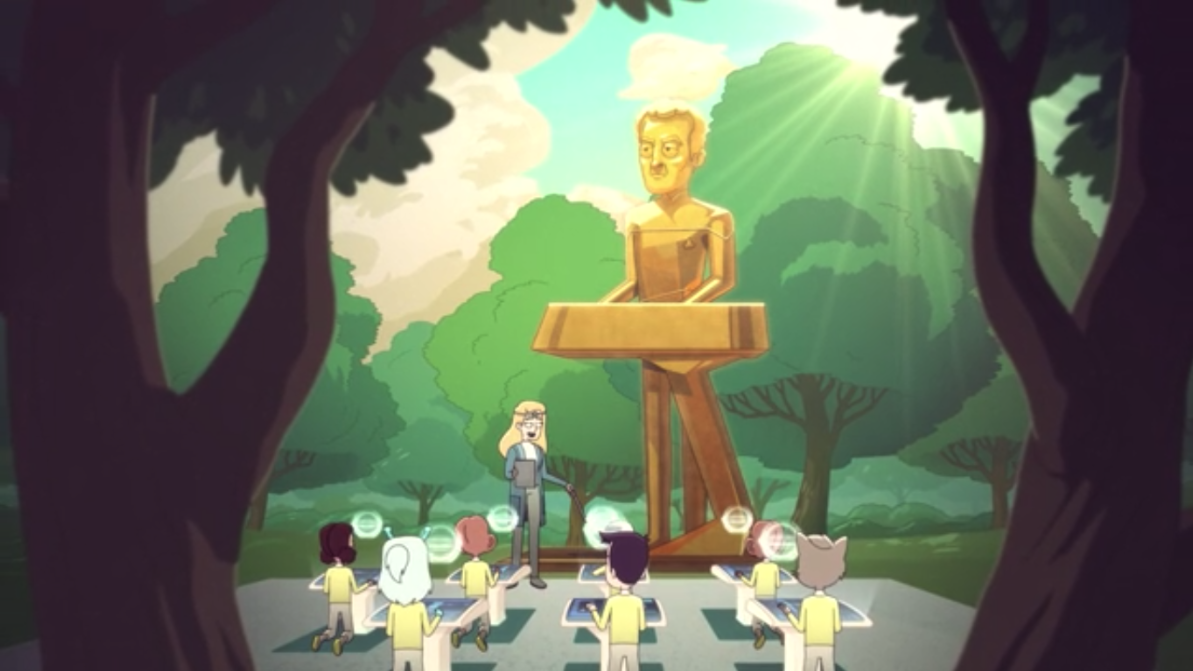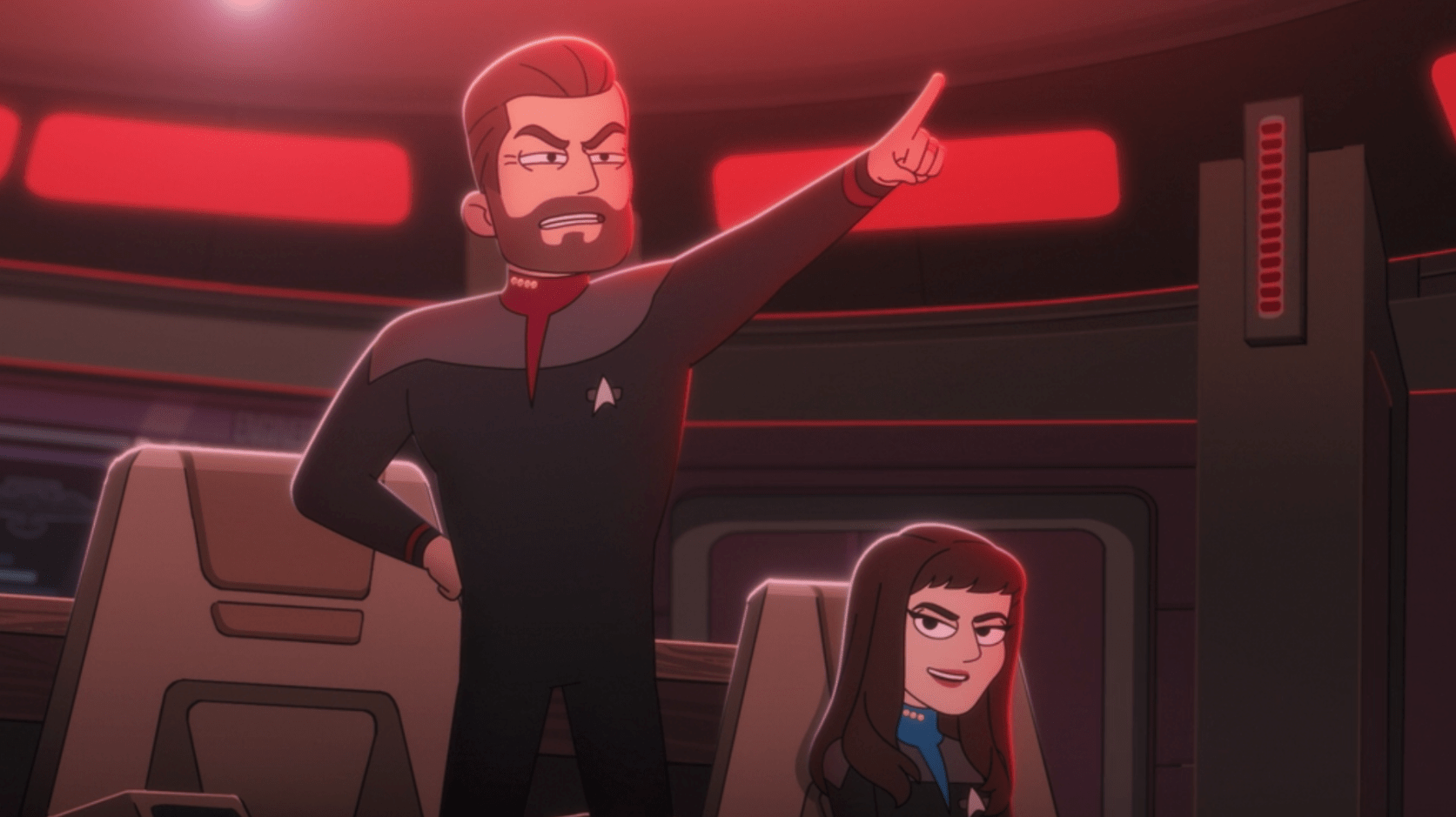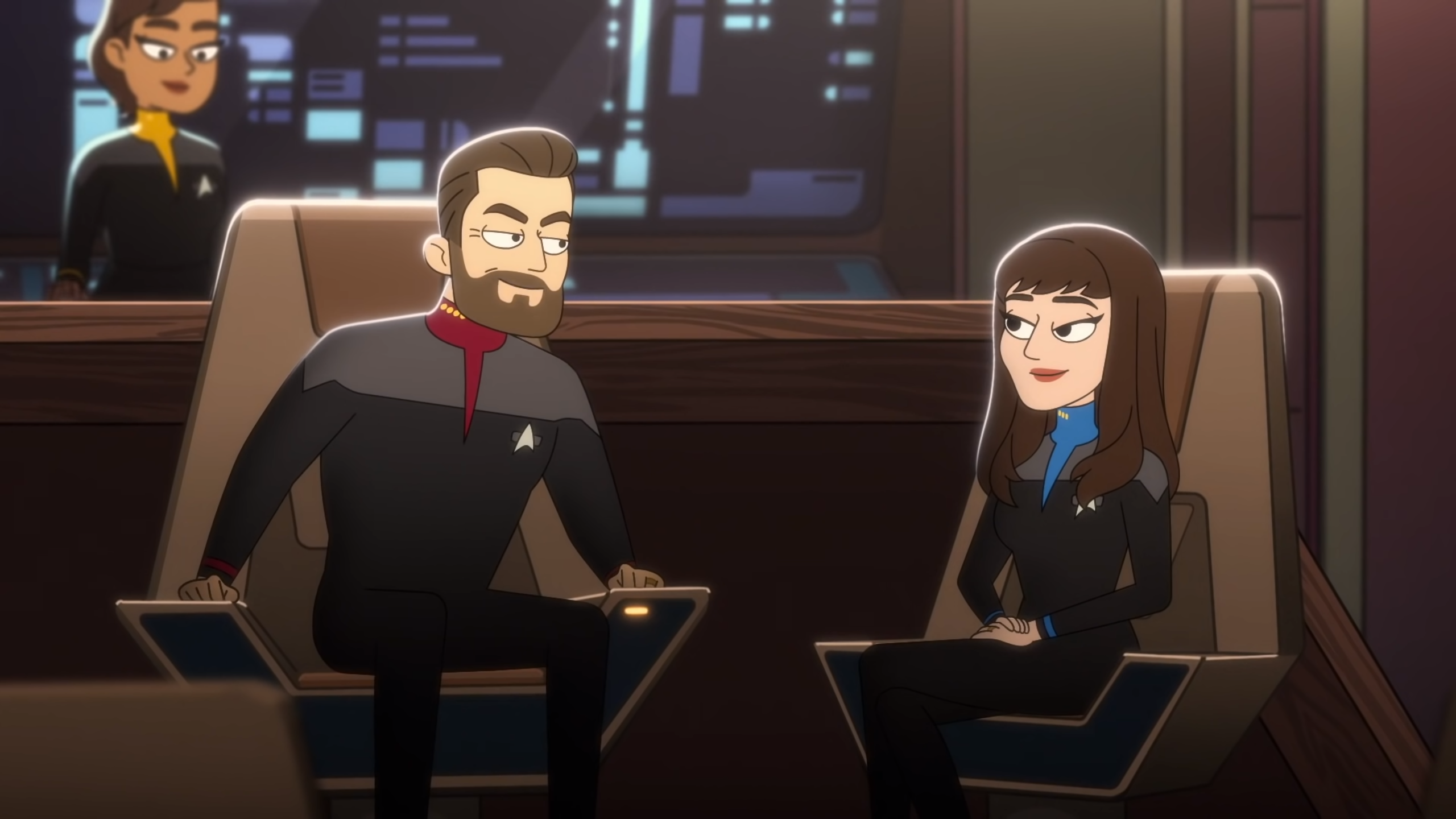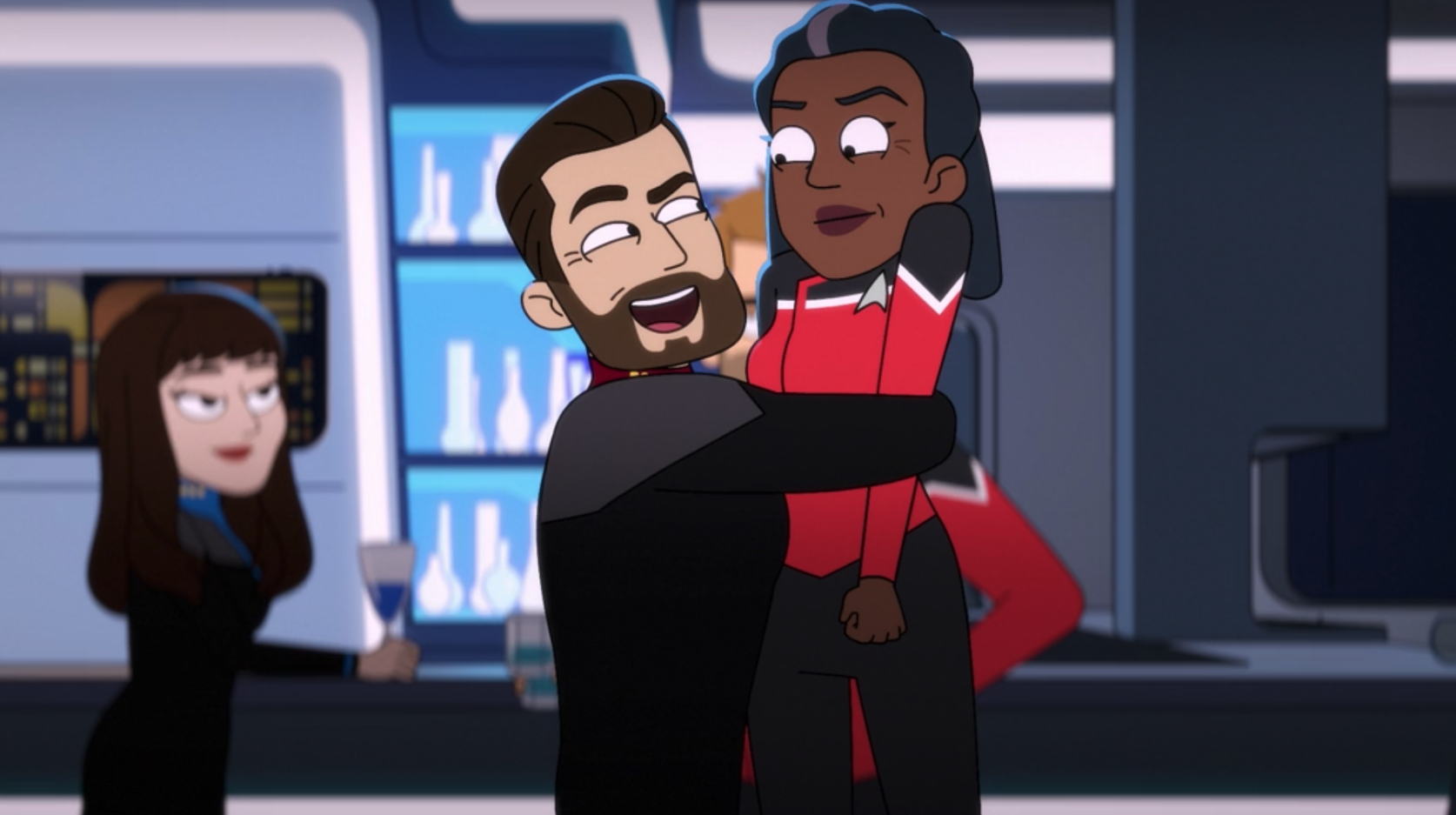Lower Decks is a show that rejoices in the nerdy little details of Star Trek. From Pakleds to Exocomps, from Kirk punches to movie riffs, its first season delivered a show that earnestly loved Trek’s ideals and the callbacks that made it such a rich franchise in the first place. But when the show wanted to pull out the big guns, it knew it had to make those appearances matter for the animated series.

Over the course of the show’s first season — set in 2380, just a year after Star Trek: Nemesis — there were several levels of cameos from the TNG era that all displayed Lower Decks’ love of a good Trekkie gag and how much the series knew when to let its new characters take centre stage. Early on we got a delightfully silly visual gag with TNG and DS9 icon Miles O’ Brien, and then John de Lancie reprised his role as the omniscient arsehole Q for a brief moment in the back half of the season.
But perhaps the biggest of all came in season one’s finale, when, after the crew of the U.S.S. Cerritos came together to save their ship from the scavenging hands of the not-so-unthreatening Pakleds, Captain Will Riker and Deanna Troi with the crew of the Titan — a ship never before seen in a Trek TV show until now — warped in to help scare the Pakleds away. All these cameos are, much like Lower Decks, on the surface about having a bit of fun with the Star Trek universe. But for showrunner Mike McMahan, part of his challenge in bringing the show to life with the crew behind it was making them all feel earned and not like they were undermining the new characters on the show.
“It was three things concurrently working together,” McMahan told Gizmodo over the phone, speaking about Chief O’Brien’s brief cameo at the end of “Temporal Edict,” the third episode of the season. “The first one being, you know, Miles O’ Brien is the epitome of a lower decker — going from the bottom and going all the way to kind of the top. We saw him as a background character on TNG, and then he eventually gets more storylines as they’re building him out, and Colm Meaney is such a great actor that he becomes this part of TNG. And then obviously moving on to Deep Space Nine is when he really blossoms, the stories with him were so fascinating, and he has his friendship with Bashir. Of course our show would make a gold statue of that character because he’s doing what our show thematically is doing.”
But O’Brien, in his relationship with Deep Space Nine’s stiff upper-lipped doctor, also represented the kind of Starfleet camaraderie McMahan wanted Lower Decks to celebrate as well. “I love friendships in Star Trek,” McMahan continued. “Kirk and Spock, Data and Geordi, and honestly, O’Brien and Bashir is awesome. Those guys are playing racquetball all the time, I love those guys.”

O’Brien was also the kind of hero Lower Decks wanted Boimler, Mariner, Rutherford, and Tendi to be: important characters who keep Star Trek’s universe going but would never get their own splashy CBS All Access show (until they did, that is). “We were writing that episode while we knew there was a whole show called Star Trek: Picard out there,” McMahan laughed. And it didn’t ever feel like there would be a show called, you know, Star Trek: Any Other Character. Like, Picard is such a huge character, he would get his own show.”
The expectation Picard brought helped seal the deal on the O’Brien gag for McMahan. “[We] jump ahead to the future, there’s all these futuristic, you know, like this beautiful group of different kinds of species from TNG. They’re all sitting there learning and like a beautiful outside environment. And they’re about to learn about the most important person in Starfleet,” the showrunner added. “The audience’s brains should have been like, ‘Oh, I’m about to see a statue of Kirk, of Picard, or one of these usually celebrated people.’ And it just really tickled us to be like, ‘No, let’s subvert that, it will be comedic that it won’t be one of those other guys, and instead it’s this guy that we like.’”
McMahan had another reason to give Miles a call out that reaches back into his own Trek fandom before he was helping to build a show in the franchise — pulling on fan works he was both involved in and admired that set the stage for Lower Decks’ loving satire of Star Trek. “Back when I was writing the TNG season eight comedy Twitter feed, and I was also a little bit after that reading the Chief O’ Brien At Work comic by Jon Adams. It’s so funny, and I’ve become friends with him and had dinner with a couple times because of our love of Star Trek. I just wanted to put a little shoutout to Chief O’Brien At Work, that’s why specifically it’s O’Brien at his console in the transporter room instead of O’Brien on Deep Space Nine fighting Cardassians.”
If Miles represented Lower Decks’ unsung heroes and the bonds they forge, then its biggest cameos had to stand shoulder to shoulder with those heroes after their own arcs had climaxed in the season finale. After Boimler, Mariner, and the rest of the Cerritos crew came together to make sure the Pakleds couldn’t tear the ship apart for, well, parts, they find themselves facing even more Pakled ships…until the timely arrival of the U.S.S. Titan and its crew, captained by none other than William Riker. It’s the second time this year Jonathan Frakes has shown up to save a Star Trek show’s season finale.
“I knew that Riker and Troi were going to show up in Picard,” McMahan said of the surprising similarity between it and Lower Decks’ tactical Imzadi deployment. “I did not know that at the very end of Picard, Riker swoops in to save the day with a fleet. I do have to admit, when I did find that out, we were so deep into production, because animation has such a different cycle than live-action, that it was far too late to do anything to make to soften the kind of similarities. To be totally honest, while it feels for a fan like it has an echoing similarity to it, it’s a different era, a different ship.”

What makes Riker’s second instance of showing up as the Starfleet cavalry different for McMahan is that the moment is not just about Riker. “It’s also the Titan. It’s this idea that, like, this other non-Enterprise ship, of a person who’s moved up in rank like that, the Titan itself is such a big character in that moment,” McMahan explained. “And then, of course, the style of the uniform and Troi being there, and that moment of everybody being rewound back in time to 2380, it does feel significantly different [to Picard].”
“The Riker you meet in Picard has been through so much more in life than our Riker,” McMahan continued. “Our Riker is kind of like, a dad, who loves being a dad of a ship. He’s making dad jokes, he loves jazz, he loves saying ‘Give me warp in the factor five, six, seven, eight!’ I think he goes to warp eight all the time, just so he can say that.”
The triumphant arrival of Riker, Troi, and the Titan is Lower Decks celebrating the larger part of itself in the most nostalgic way — old friends, phasers firing away as a beloved fan-favourite ship, never officially seen on TV before, saves the day and the TNG theme blares in the background. And because of that, McMahan wanted to ensure that Lower Decks wasn’t flippant about leveraging these characters. “That’s a huge episode with a huge moment in it, right? We just wanted it to be both…we wanted to geek out hard, because we got to do it, but we also wanted to be really careful with it,” McMahan said.
[referenced id=”1226114″ url=”https://gizmodo.com.au/2020/06/star-treks-starfighters-ranked/” thumb=”https://gizmodo.com.au/wp-content/uploads/2020/06/26/t5smv8rk967cnhh84pmr-300×169.png” title=”Star Trek’s Starfighters, Ranked” excerpt=”Wars in the Stars: here’s the best of the starfighters the Star Trek galaxy has to offer.”]
“Part of the carefulness is with working with John Van Citters [Vice President for Star Trek Brand Management] and CBS to make sure we have all of their internal designs for the Titan, which had never appeared on screen before but had been on the cover of books, and had been in games. We just wanted to make sure we got it right because there are fans out there for who the Titan is a favourite ship. We weren’t gonna step on that. And then working with our CG team so that when it comes in, it really feels like the Titan, because we were the first people who were going to define what the Titan looks like and how it moves on screen.”
That level of detail applied to how Lower Decks visualized Riker and Troi, too. “On top of that, making sure that the designs for [Jonathan] Frakes and Marina [Sirtis] fit into the show and fit in the era for them. But another element for it was my kind of fandom for those two, being the kind of things that I am in love with them for — that those were expressed in it,” McMahan added. “Not just things like the Riker design being tall, but making sure things like, Marina’s pupils were bigger on the Troi design, in the actual drawings. I just wanted to make you feel like you could go ‘Oh, I wish I could see a whole show about what those guys are up to on the Titan,’ like, what’s their show like? Making it feel like this was one day in a bigger story about those guys.”
It was a big moment for McMahan as both showrunner and Trek fan because he got to collaborate in nailing those performances with Frakes and Sirtis themselves. “Frakes is so funny,” McMahan gushed in awe. “We had a blast recording him. In fact, we expanded the role in the booth with him, because he was making us laugh so hard. We kept adding lines — because of course the whole writing staff was there because they’re not gonna miss a Frakes recording. And just the dynamic between him and Troi, you feel like that’s gonna be there, but getting to actually see them express it…I was completely geeking out.”
McMahan added, “It’s a little embarrassing to say, but I did have Frakes sign my horga’hn [the Risan fertility statue Riker gifts to Picard in “Captain’s Holiday”]. It was an absolute joy to work with them.”

It was a delightful moment for the show and the people behind it, but for McMahan, that moment could only work with everything Lower Decks season finale had already built up with its own characters. Riker and Troi don’t save the day, truly: the crew of the Cerritos does, and the Titan’s there to help finish it off. “In the actual script, it was a really delicate moment, because we wanted Riker to show up with Troi and the Titan to quote-unquote ‘save the day,’ but we didn’t want to undo the victory the Cerritos just had by working together,” McMahan said of crafting the finale’s climax. “The whole episode is about truths coming out, villains coming in, things going crazy, but at the end of the day, the Cerritos fucking brings it, right?”
“The crew can come together and they managed to save the day. The episode could end there. Like, everybody’s cheering — they’ve lost Shaxs [Fred Tatasciore’s Bajoran security chief, who dies saving Rutherford in the finale], but Shaxs sacrificed himself to save the whole crew. They’ve won. The episode could’ve ended there, if you watch it again, that moment — we could’ve just faded out to the spacedock. It needed to feel like a finale. We needed to have those guys show up.”
For Lower Decks then, the nostalgic arrival of familiar faces was more of a reward than it was the answer to its character’s problems. “Instead of them being deus ex machina, I guess we kind of villain ex machina’d more Pakleds showing up,” McMahan joked. “Let’s have that finale moment, that pit in your stomach — ‘Oh no!’ — where they’ve overcome insurmountable odds against this one giant ship. We’ve already seen it destroy a ship in the opening of the episode and then, when they’ve won, when they’ve finally done it, three more Pakled ships show up! [They] don’t have another Shaxs, [they] don’t have Rutherford on the ship anymore [to upload his virus]. There’s no way we can end on these ships, and they’re gonna tear the Cerritos apart.”

“That’s almost beginning a new story, a darker story. The Cerritos was scrappy this episode, even though they’re not the best or biggest ship in the fleet, they managed to pull it out. Then they’re gonna get destroyed! That’s when Riker and Troi show up, in that new beat at the end. It was important to me that it was a celebration of Starfleet in general, that this was the ‘forgotten ship’ and that they’re all working together one more time.”
“Even more important to me than the Titan showing up was that bar scene [at the end]. Again, I love Star Trek friends, and getting to see Riker call the captain his cha’DIch [the Klingon term for someone who would fight on your behalf in an honour duel challenging the High Council], and being with Mariner…that friendship is almost more important to me [than the nostalgia],” McMahan concluded. “The finale is a joy. I think it’s the episode that took me the least amount of time to write, I felt like I was watching it when I was writing it — and just an absolute love letter to everything, but especially….I just, I love Riker and I love Troi. And it was important to me that we use them carefully, but also just in a great way.”
Stay tuned to Gizmodo for more from McMahan breaking down the first season soon!
